Abstract
The structural integrity of nuclear fission and fusion power plant components is the focus of this research. The state of the art is using micro scale specimens milled with a focussed ion beam (FIB). Because of their very low volume such specimens can be lab tested, even when irradiated to low or medium level of activity. This offers a possibility of testing multiple specimens to investigate stochastic effects, e.g. effects of irradiation on the shift of the ductile to brittle transition. However, FIB milled specimens suffer from Ga contamination, to the degree that the validity of fracture data obtained on such specimens is questionable. We propose to use nano-additive manufacturing as an alternative to FIB for making micro scale fracture specimens. A combination of two-photon polymerization and electrodeposition and sputtering was used to manufacture micro-scale Brazilian disk fracture specimens (CBD), which are free from Ga and thus better suited for the study of irradiation effects on structural integrity. In this study Ni CBD specimens were made with 30 μm diameter and up to 13 μm thickness. The slot width varied between 1 μm to 2.9 μm width the corresponding slot length of between 7.5 μm and 8 μm. Consecutive FIB characterization shows that the specimens have polycrystalline microstructure with sub-μm grains. The work is ongoing making W CBD specimens and on reducing the slot width and using chemical vapor deposition fabrication.
Similar content being viewed by others
References
M. Klimenkov, U. Juntsch, M. Rieth, et al., Nuclear Materials and Energy 1–4 (2016).
S. Nagata, H. Katsui, K. Hoshi, et al., Journal of Nuclear Materials 442 328–332 (2013).
E. M. Grieveson, D. E. J. Armstrong, S. Xu, and S.G. Roberts, J. Nucl. Mater. 430, 119–124(2012).
M. Mostafavi, R. Bradley, D. E. J. Armstrong, and T. J. Marrow, Sci. Rep. 6 (2016).
K. Thompson, B. Gorman, D. Larson, B. van Leer, and L. Hong, Microsc. & Microanalysis 12, 1736 (2006).
Z. Wang, T. Kato, T. Hirayama, N. Kato, K. Sasaki, and H. Saka, Appl. Surf. Sci. 241, 80–86 (2005).
B.R. Jany, K. Szajna, M. Nikiel, D. Wrana, E. Trynkiewicz, R. Pedrys, F. Krok. Appl. Surf. Sci. 327, 86–92 (2015).
J. Mayer, L.A. Giannuzzi, T. Kamino and J. Michael, MRS Bulletin 32, 400–407 (2007).
Stratulat, D. E. J. Armstrong, S. G. Roberts, Corrosion Sci. 104, 9–16(2016).
G. von Freymann, A. Ledermann, M. Thiel, I. Staude, S. Essig, K. Busch and M. Wegener, Adv. Funct. Mater. 20, 1038 (2010).
L.-F. Chen, M. P. C. Taverne, X. Zheng, J.-D. Lin, R. Oulton, M. Lopez-Garcia, Y.-L. D. Ho, J. G. Rarity, Opt. Express 23, 26565–26575 (2015)
G. I. Williams, M. Hunt, B. Boeheme, M. Traverne, Y.-L. D. Ho, S. Giblin, D. E. Read, J. G. Rarity, R. Allenspach, and S. Ladak, Nano Res. (2017). doi:10.1007/s12274-017-1694-0.
Author information
Authors and Affiliations
Corresponding author
Rights and permissions
About this article
Cite this article
Taverne, M.P.C., Zeng, X., Morgan, K.A. et al. Fabrication of micro-scale fracture specimens for nuclear applications by direct laser writing. MRS Advances 3, 1771–1775 (2018). https://doi.org/10.1557/adv.2018.236
Published:
Issue Date:
DOI: https://doi.org/10.1557/adv.2018.236




